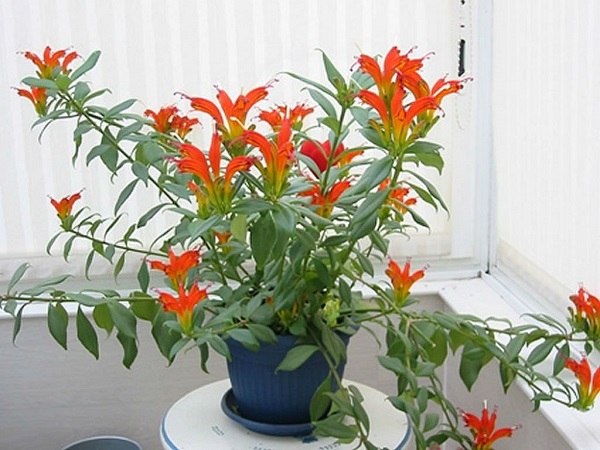
The Aeschynanthus is a genus of evergreen subtropical and tropical plants in the Gesneriaceae family. It is an eye-catching hanging plant with long trailing stems, waxy leaves, and red flowers. The most common variety is a trailing perennial also known as Lipstick Plant. It is a flowering indoor plant that has shiny foliage and interesting flowers. It gets its name because the flower buds peek out of dark-colored tubes, looking like a miniature tube of lipstick. Lipstick plant can be a bit fussy, and you must keep water and direct sunlight off the leaves. Moreover, it doesn’t like cold droughts, dry air, and wet soil in winter. It makes the perfect choice for use in hanging baskets, as the stems grow 2-feet long or even longer and will bring a bit of the tropics indoors wherever placed. Keep it away from children and pets because it can be toxic.
Growing Instructions
Soil

Pot your Lipstick Plant in fertile soil that drains well and water it when the top quarter of the soil becomes dry. Make sure you use soil that is well aerated and isn’t heavy, as heavier soils don’t drain properly and remain too wet. A potting mix designed specifically for houseplants works well or even a fertile, lightweight regular potting mix is suitable.
Fertilizer
Fertilize lipstick plant monthly in the spring and summer to help it produce abundant flowers. Use any general-purpose houseplant fertilizer. Just be sure to follow the instructions on the product’s packaging and be careful not to overfertilize.
Temperature
Make sure it is in a high humidity environment in temperatures 75°F to 85°F. Lipstick Plant will tolerate temperatures down to 60°F but the growth slows. When indoor temperatures drop to 50°F or lower, the plant suffers tissue damage and leaf drop. This is a tropical plant that is accustomed to warm temperatures and a humid environment year-round.
Light
Grow lipstick plant in a medium to bright spot, but make sure to avoid direct sunlight as it can make the foliage burn. The more light it receives, the better it will bloom. If you have a lipstick plant that won’t produce flowers, try moving it to a brighter spot.
Watering
Don’t let lipstick plant wilt, but also take care not to overwater it. If this houseplant stays too wet, it will suffer from root rot. An easy way to check the soil’s moisture level is by sticking your finger into the soil and if the top quarter feels dry apply water. Always water until it runs from the bottom drain holes of the container. Signs your Lipstick Plant isn’t getting enough water is shriveled leaves. If you are overwatering the plant, the foliage starts losing its shiny green color. For the health of the plant, it is better to miss a watering than to regularly apply too much. Waterings can be cut back during winter.
Repotting
The only time you will need to repot is if it has outgrown its current pot and the roots are filling the bottom. Use a container that is one size larger than the present one and repotting is best done while it is actively growing in spring through summer.
Pruning
To promote bushier growth, you can prune back the long stems, cutting off about a third. This keeps the plant from becoming leggy and looking straggly. It’s best to wait until after the blooming has finished before pruning. Since the flowers form at the leaf tips, pruning will create more blooms for you to enjoy.
Fun Facts About Lipstick Plant
Lipstick Plant, also called Lipstick Vine is native to the tropical and humid rainforests of Java north to the Malay Peninsula where the long, trailing vines grow and scramble along trees. It belongs in the Gesneriaceae family, which is the same family as the African Violet, and the genus Aeschynanthus that includes around 150 different species of tropical plants, including the Lipstick Plant. When properly cared for and grown in proper conditions, Lipstick Plant vines can grow 2- to 3-feet long.
Related Articles & Free Email Newsletter Sign Up
Oxalis is a Great Plant for Your Greenhouse
The Swiss Cheese Plant Has Holes in Leaves for a Reason




Comment here